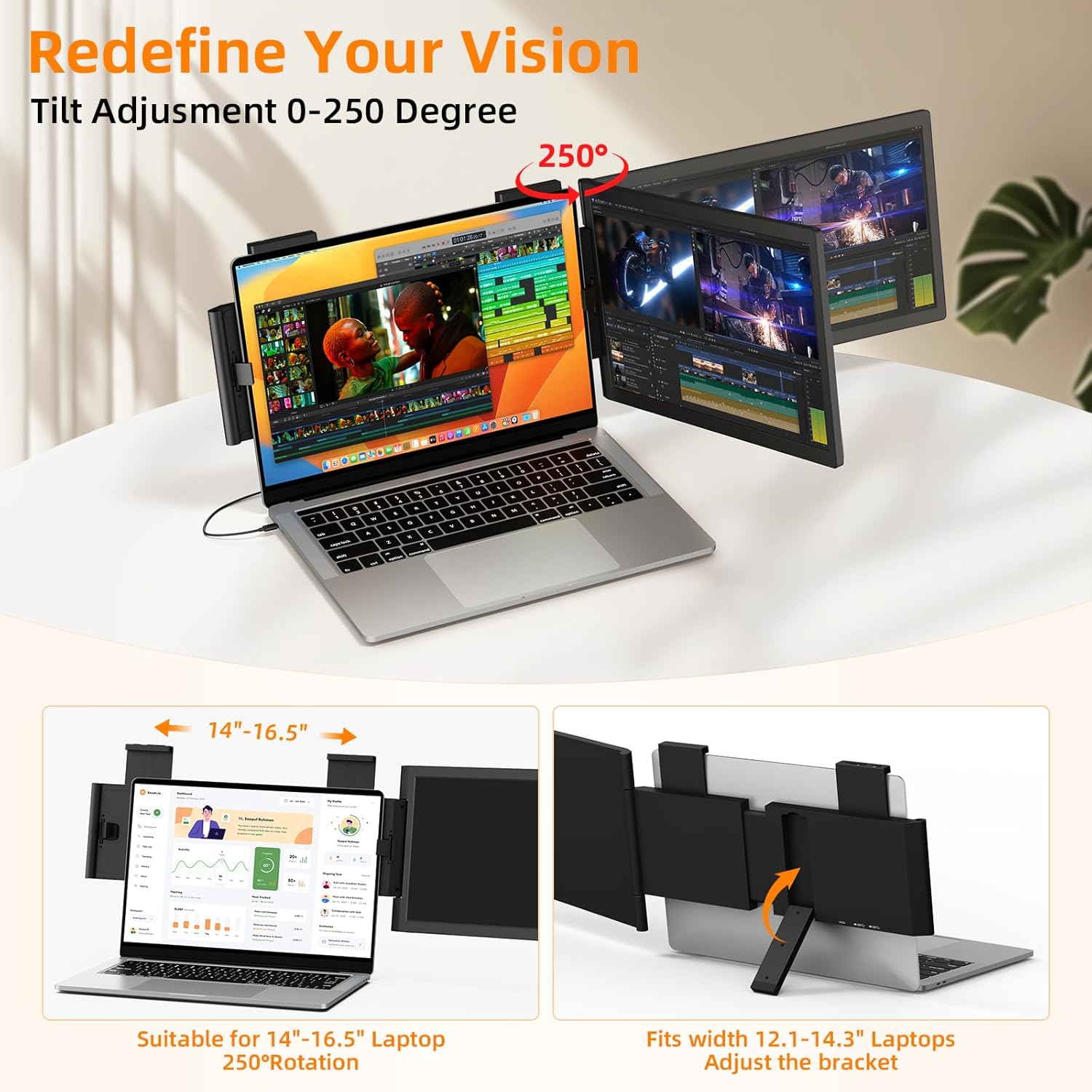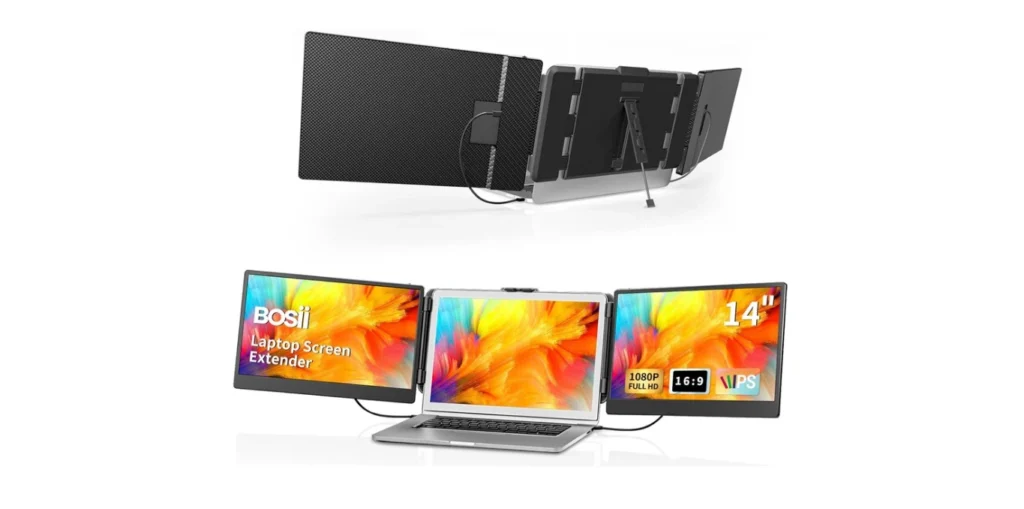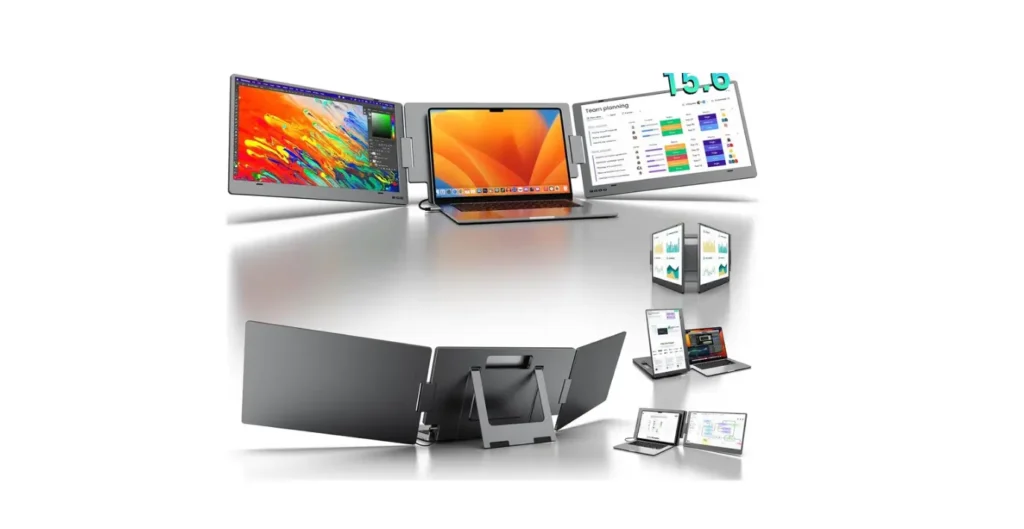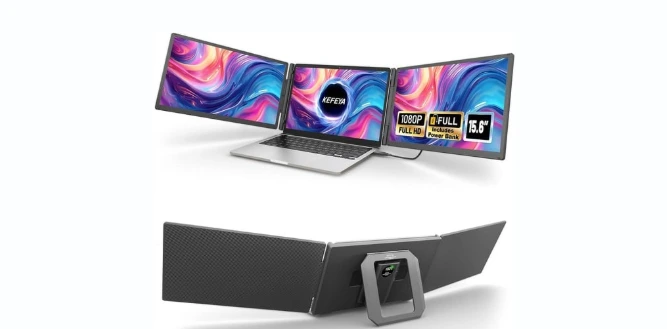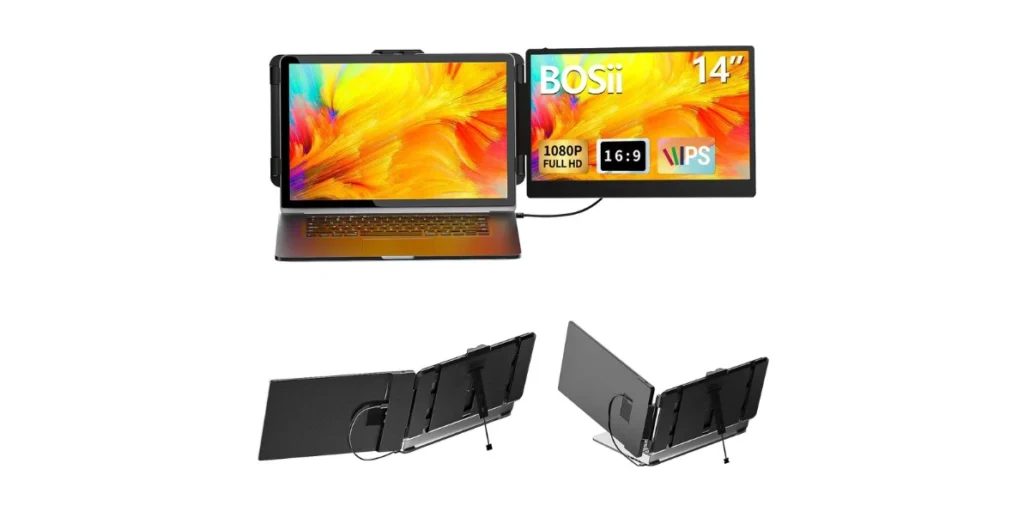Do we really need another screen in our lives, or are we simply looking for an excuse to avoid the laundry?
What This Portable Monitor Is, and Who We Think It’s For
We’re talking about a 14-inch Full HD IPS portable monitor that functions as a laptop screen extender. It connects via Mini HDMI or USB-C, and it’s marketed as plug-and-play for Windows, Mac, Android, Nintendo Switch, and PS5. It’s designed to pair neatly with laptops roughly in the 14 to 16.5-inch range, which should satisfy those of us who like symmetry and the illusion of order.
We see this as a tool for people who want a second display without committing to a full desk setup—students bouncing between lecture halls, professionals who conduct meetings from kitchen counters, frequent travelers who have memorized the price of airport salads, and anyone trying to nudge productivity forward without hauling a desktop monitor around.
Design and Build: The Comfort of a Straightforward Rectangle
There’s something calming about a tidy rectangle that doesn’t ask to be admired but quietly does its job. This 14-inch portable monitor lives in that space. It’s compact enough to slip into a backpack sleeve and large enough to be genuinely useful rather than a token gadget that plays a supporting role.
We appreciate that it’s purpose-built for laptops in the 14″–16.5″ range. That doesn’t mean it won’t work with smaller or larger machines—it will—but visually and ergonomically, it aligns best with those sizes. If we worry about balance (literal and figurative), that’s reassuring.
Display Quality: Full HD IPS That’s Easy on the Eyes
We’re not getting laser light shows here, and that’s a good thing. Full HD (1920×1080) on a 14-inch panel is sharp enough for spreadsheets, documents, Zoom grids, and even video editing timelines. The IPS panel brings comfortable viewing angles, so if we lean off to one side like we’re trying to eavesdrop on our own work, the image still holds together.
Colors are crisp and consistent for everyday use. As with most portable monitors in this category, this isn’t aimed at colorists or photographers who need certified accuracy for professional print work. But for web design, presentations, coding, writing, streaming, and remote collaboration, it looks clean and perfectly respectable.
Setup and Connectivity: The “Plug & Play” We Actually Want
Cables can break our spirit, so here’s the gist. We can get this monitor going in one of two primary ways:
- USB-C with DisplayPort Alt Mode: One cable for video and power, if our device supports it.
- Mini HDMI for video + USB-A/C for power: Two cables, one for video, one for power.
The product supports Windows, Mac, Android (via compatible USB-C phones/tablets), Nintendo Switch, and PS5. That means we can use it for work during the day and for games after hours without rethinking our entire technology ecosystem. We just need to bring the right cable. Or, if we’re like us, a small pouch of all cables, because we trust no one, least of all ourselves.
What “Plug & Play” Looks Like for Different Devices
We appreciate when plug-and-play is truly plug-and-play. Here’s how it usually plays out across platforms:
- Windows laptops: If our laptop has a USB-C port that supports video (DisplayPort Alt Mode), we’re in. One cable usually does it. Otherwise, mini HDMI for video and USB for power works reliably. Windows detects the screen and gives us the usual extend/mirror options.
- Macs: MacBooks with USB-C/Thunderbolt should support a single-cable connection. If we prefer mini HDMI, that works too—just power the monitor via USB. macOS handles scaling sensibly, though we might need to tweak arrangement and resolution.
- Android: Many newer Android phones and tablets support video output over USB-C. We can extend (or mirror) the display, which is surprisingly handy for notes or streaming. We’ll want to confirm our device supports DP Alt Mode.
- Nintendo Switch: With the right adapter and power, the Switch connects via HDMI. Ideal for hotel nights where the TV is a mystery and the room lighting is from a noir film.
- PS5: Plug in via HDMI and power the monitor via USB. The PS5 outputs 1080p to it without argument.
Ergonomics: A Small Change That Feels Like a Big Deal
There’s a meaningful difference between switching windows on a single screen and parking different tasks on separate displays. With a second monitor, we can keep a document on one side and our notes or emails on the other. We don’t even realize how much cognitive bandwidth we’re wasting until we stop doing the window shuffle altogether.
The monitor’s 14-inch size hits a sweet spot. It’s compact enough to be portable but gives us enough real estate to run two windows side by side or keep reference material visible. If we’re working in coffee shops and airplane trays, it’s not cumbersome. It’s the café equivalent of a good shoulder bag: doesn’t look like much, but it carries more than we’d expect.
Everyday Use: Productivity Without the Drama
After a few days, the second screen stops feeling like a luxury and more like a basic right. We reserve it for whatever most often triggers annoyance: endless chat threads, columns of data, preview windows, or that calendar with eight overlapping rectangles that looks like a modern art critique of time.
We use it for:
- Research on one screen, drafting on the other
- Spreadsheets stretched without squinting
- Video calls with notes visible without awkward alt-tabbing
- Coding with terminal logs or documentation beside the IDE
- Slide editing while viewing speaker notes and references
- Streaming something quietly while reformatting documents (we all do it; let’s be honest)
And when the day is over: plug in a Switch or PS5, lean back, and feel like we’ve earned this.
The Learning Curve: Flat, Like a Calm Lake
Once we understand which cable does what, the learning is minimal. Windows and macOS both offer displays settings that are mercifully humane these days. We drag the monitors around to match the physical layout, tweak brightness to suit our environment, and we’re done. We don’t need apps or drivers for basic use, which we consider the very definition of civility.
A Quick Look at Specs and Compatibility
Sometimes it helps to see things at a glance. Here’s a practical summary of what matters:
| Feature | What We Get | Why We Care |
|---|---|---|
| Screen size | 14 inches | Balanced for portability and usable workspace |
| Resolution | Full HD 1920×1080 | Sharp enough for work and streaming |
| Panel type | IPS | Wide viewing angles and consistent color |
| Refresh rate | Up to 60 Hz (typical) | Smooth enough for work and casual gaming |
| Inputs | USB-C (DP Alt Mode), Mini HDMI | Flexible connections for laptops, consoles, mobile |
| Power | USB-C or USB-A to USB-C | Can run from laptop or power adapter |
| Compatibility | Windows, Mac, Android, Switch, PS5 | Use it for work and play without fuss |
| Laptop pairing | Designed for 14″–16.5″ laptops | Aligns visually and ergonomically |
| Use case | Portable second screen | Productivity boost with very little baggage |
We encourage checking the ports on our laptop to confirm whether USB-C supports video output. Not all USB-C ports are created equal; some are purely for data or charging. If in doubt, mini HDMI plus USB power is the fallback that just works.
Visual Tuning: Small Adjustments, Big Comfort
Bright coffee shop? Dim hotel room at 11 p.m.? We’ve been in both. Adjusting the brightness is straightforward, and IPS handles ambient light more gracefully than cheaper panels. We typically set brightness to a comfortable midpoint and nudge it depending on lighting. Our eyes thank us, though usually in the quiet way eyes do.
Color profiles on portable monitors are usually simple. We like to keep things neutral—no overcooked saturation or aggressive contrast unless we’re watching something specifically cinematic. Skin tones look good, text is crisp, and we don’t feel like we’re staring into a nuclear test site.
Gaming: Keep Expectations Sensible and Fun
This isn’t a competitive esports display, and we don’t need it to be. For story-driven games, indies, retro collections, and console staples, 1080p at a standard refresh rate is perfectly enjoyable. We’ve used portable monitors for couch-adjacent gaming and travel setups, and they’ve saved more weekends than we care to admit.
On PS5, the monitor accepts a 1080p signal. We’re not getting 4K or 120 Hz, but for many titles, frame pacing and art direction matter more than raw numbers. On the Switch, 1080p is a best-case docked output anyway, so it pairs naturally.
Travel and Portability: Finally, Something That Earns Its Space
We’ve hauled around external keyboards, USB hubs, a mouse shaped like a small whale, and cables that tangle themselves on purpose. A 14-inch portable monitor is one of the rare additions that earns its keep after a single flight.
We slip it into a padded sleeve with a microfiber cloth, toss in a short USB-C to USB-C cable, a mini HDMI cable, and a USB power cable. That’s the standard kit. If we want to be extra careful, we add a slim stand or use whatever built-in support or case-integration the package provides. The footprint on a tray table is surprisingly manageable.
Setup Tips That Save Time (and Arguments with Ourselves)
We’ve learned a few habits that make life better with a second screen, especially on the road:
- Label cables. Future us never remembers which USB-C is actually rated for video.
- Use short cables. Long ones tangle, and we only need to reach a foot or two.
- Arrange displays in the OS to match reality. If the monitor sits to the right, put it there in settings. Our mouse will thank us.
- Bring a small USB power adapter. If our laptop battery is precious, powering the monitor externally leaves more charge for the main machine.
- If using Android, test at home. Some phones play nicer than others, and we prefer our hotel experiments to be limited to continental breakfast selections.
Workflows We Love With a Second Screen
There’s no one right way to use a second display, but some setups feel wonderfully natural:
- Writing + Reference: Draft on the laptop screen, keep research, images, or a style guide on the portable monitor.
- Video Calls + Notes: Zoom on one display; notes, agenda, and links on the other. No alt-tab panic when someone says, “Could you pull that up?”
- Design + Assets: Main application on one screen, asset browser or layout preview on the other.
- Code + Logs: IDE on the laptop, logs/terminal or documentation on the side.
- Spreadsheet + Email: One window to calculate, one window to apologize for deadlines.
The 14-Inch Sweet Spot: Why Not Bigger or Smaller?
We’ve tried 13.3-inch monitors and 15.6-inch ones. The former can feel a bit cramped; the latter is great but verges on slightly unwieldy for travel. Fourteen inches hits the Goldilocks zone. We get real workspace without needing a larger bag or a bigger table. Also, it pairs neatly with a wide range of laptops, which saves us from mismatched aesthetics that make us feel unsettled in a way we can’t quite explain.
Sound and Extras: Keep It Simple
Portable monitors in this class sometimes include basic speakers, but we don’t treat them as replacements for anything beyond casual listening. If we care about sound, we’re using headphones or laptop speakers anyway. For the purposes of this screen, what matters most is visual clarity and reliable connectivity. Everything else is secondary.
Reliability: What We Watch For Over Time
We look for consistent performance across different devices, minimal cable fuss, and build quality that doesn’t scuff at the first sign of a zipper. Sturdy casing, clean ports, and responsive on-screen controls go a long way. We prefer devices that don’t require proprietary drivers, because nothing ruins a morning like driver installation in a coffee shop with questionable Wi-Fi.
As for the IPS panel, it should remain stable over time—no weird ghosting, no color shifts after a month, no flicker at reasonable brightness settings. These are the quiet victories we enjoy more than we should.
Polishing the Experience: Stands, Sleeves, and Small Luxuries
Depending on how we work, a simple stand can help angle the screen comfortably. If the monitor arrives with a case or integrated support, that might be enough; if not, a compact foldable stand is inexpensive and worth it. We’ve also become fans of hard-shell sleeves with soft linings. The fewer surprises inside our backpack, the better.
Cable management is non-negotiable. We keep:
- A 1–1.5 ft USB-C to USB-C (video + power)
- A short USB-A to USB-C (power only)
- A short mini HDMI to HDMI cable (video)
We tuck them into a zipper pouch, because rummaging in public makes us look like we’re performing a magic trick we haven’t rehearsed.
Value: What We’re Paying for, and What We Actually Get
It’s not the cheapest gadget we can add to our setup, but it’s one of the most immediately useful. A second screen is a force multiplier: it reduces task-switching, lowers friction, and cuts the time we spend hunting for windows. That translates to saved time, better focus, and less frustration—aka real value.
We also get flexibility: work during the day, games at night, portable presentations, and the ability to create a pop-up workstation in spaces that frankly weren’t designed for work. This sort of resilience becomes part of our routine.
When It Shines, and When It Doesn’t
We’re not going to pretend this monitor is a universal miracle. Here’s where it’s brilliant, and where it’s just okay:
Shines:
- Portable productivity and travel setups
- Remote work with limited desk space
- Students and presenters who need a flexible display
- Casual console gaming and streaming
- Side-by-side app work without a full home office
Just okay:
- Color-critical photo work or HDR grading
- High-refresh competitive gaming
- Sunlit patios at high noon (few screens excel here)
- Audio-first experiences without headphones
And that’s fine. It does what it promises in the categories that most of us live in day to day.
Responsible Expectations: USB-C Nuances and Power
Not every USB-C port carries a video signal. We’ve made this mistake enough times to remember it in our bones. Laptops often label ports with a tiny DisplayPort logo or lightning bolt; check the manual if we’re unsure. If we don’t have a video-capable USB-C port, we can still use mini HDMI for video and power the monitor from any reliable USB port or adapter.
Power draw is modest, and in many cases, our laptop can handle powering both itself and the monitor. That said, if we’re doing heavy tasks or running on battery, we might prefer to plug the monitor into a separate power source so our laptop battery doesn’t evaporate before lunch.
A Day With the Screen: A Tiny Travelogue
We wake up in a hotel where the curtains were designed by someone who adored the concept of “almost blocking light.” Coffee is indistinguishable from courage. We set the laptop on the desk, prop up the monitor to the right, and connect a single USB-C cable. It springs to life with the quiet satisfaction of a well-behaved appliance. Emails on the left, slides on the right. We glance out the window, decide not to evaluate our life choices at this hour, and get to work.
During a call, the host shares a spreadsheet that looks like a satellite image of cornfields. We move it to the portable monitor, keep notes on the laptop screen, and nod in a way that says, “We are participating and alert.” After a few hours and a sandwich of indeterminate origin, we reward ourselves with fifteen minutes of Switch time. The screen moves to the coffee table. We lean on a pillow that has known better days. Everything feels improbable and also under control.
The Vision of Order: Why Two Screens Calm Our Minds
We’ve come to realize a second screen is not so much about more pixels as it is about permission. Permission to let one thing stay where it is while we focus on something else. A sense that everything has a place, even if that place is a temporary rectangle we carry in a sleeve. It’s the same satisfaction we get from a well-organized suitcase, minus the part where we forget our toothbrush.
Setup Walkthroughs by Platform
It helps to have a quick plan. Here’s how we typically set things up, step by step.
Windows Laptops
- If our USB-C port supports video, connect a USB-C to USB-C cable from the laptop to the monitor. If not, use mini HDMI to HDMI for video and a USB cable for power.
- Windows should detect it automatically. Right-click the desktop > Display settings > Select “Extend” under “Multiple displays.”
- Arrange screens to match physical layout. Adjust scale and resolution if needed.
- Optional: Assign a keyboard shortcut (Windows + P) to quickly switch between extend/mirror modes.
MacBooks
- Connect via USB-C for single-cable video and power if supported. Alternatively, use HDMI for video plus USB for power.
- Go to System Settings > Displays > Arrange to position the screens. Set resolution and scaling as preferred.
- For presentations, we like mirroring the main display and keeping a separate extended screen for notes.
Android Devices with USB-C
- Plug in via USB-C to USB-C. If our device supports DP Alt Mode, the monitor will light up.
- Depending on our phone/tablet, we may see a desktop mode or mirroring.
- Add a Bluetooth keyboard/mouse for a surprisingly laptop-like setup.
- Keep a power adapter handy; drawing video can drain a phone briskly.
Nintendo Switch
- Connect the Switch via an appropriate HDMI path (direct from a dock or via compatible adapter).
- Power the monitor via USB. The Switch should output 1080p to the display.
- This setup is perfect for quick sessions when the hotel TV refuses to cooperate.
PS5
- Connect via HDMI and power the monitor through USB.
- Go to PS5 Settings > Screen and Video to confirm resolution is 1080p.
- For couch-nearby gaming or a study-area break, this works seamlessly.
Troubleshooting the Small Stuff
A short checklist has saved us more times than we care to admit.
- No signal over USB-C? Check if the port supports video. Try a different cable that’s rated for video. Try the HDMI route to isolate the issue.
- Screen flickers? Lower brightness or use a dedicated power source. Some laptops under heavy load can’t supply steady power.
- Text looks soft? Confirm resolution is set to 1920×1080 at 100%–125% scale (Windows) or appropriate scaling on macOS.
- Colors look off? Reset to default color mode on the monitor and check any OS-level color profiles.
- Device not waking the screen? Unplug and replug the cable; sometimes we all need to start over.
Everyday Comfort: Eye Care and Posture
We often forget that comfort is cumulative. A second screen helps us stop squinting at overlapping windows, which is real progress. We also raise the laptop slightly on a stand so both screens are closer to eye level. A small external keyboard and mouse transform posture. We’ve learned that tiny fixes add up: we stretch our wrists, drink water, and pretend to know how to sit properly for more than seven minutes.
Security and Privacy: A Thought for Public Spaces
Working in public comes with the casual thrill of strangers’ eyes. If we’re viewing sensitive material, consider:
- Positioning the portable monitor away from foot traffic.
- Using dark mode where appropriate.
- Temporarily switching to mirroring to keep content contained.
- Adding a privacy screen film if we deal with confidential information frequently.
Environmental Notes: Power, Heat, and Longevity
Portable monitors sip power relative to laptops, but everything adds up. If we’re in battery-preservation mode, we reduce brightness, turn off the second screen when not needed, and let the laptop take more of the heavy lifting for intensive tasks. Heat is normally minimal, but like all electronics, it appreciates airflow and a surface that isn’t a wool blanket from the 1970s.
Gifting Potential: Yes, This Makes Us Look Thoughtful
We love a gift that improves someone’s day without requiring them to learn a new software ecosystem. This monitor is one of those gifts. It says, “We see how hard you’re working,” and also, “We recognize your dignity and wish to prevent you from tabbing between seven windows like a raccoon.” For students, remote workers, consultants, or anyone building small, flexible workstations, it’s a win.
Long-Term Use: How It Changes Our Habits
What starts as a travel accessory becomes part of our daily rhythm. We start mapping work to spaces: this screen holds the reference, that screen holds the draft. When the brain learns that certain things live in certain places, we make fewer mistakes. It’s like labeling jars in the pantry, except we’re less likely to pour cumin into our tea.
Sustainability: Using What We Have, Where We Are
The best tech lets us adapt to imperfect environments. We don’t need a dedicated home office to do good work. We need tools that bend with us—hotel desks, studio apartments, kitchen counters. A portable monitor is a small step toward that vision: we bring our environment with us, and we fit it to the day we’re having.
Final Thoughts: A Quiet Upgrade That Matters More Than We Expect
We’re fond of gadgets that don’t shout for attention. This 14-inch Full HD IPS portable monitor is one of those quiet upgrades that add up to meaningful change. It’s straightforward to set up, comfortable to use, and flexible across the devices that already live in our bag. With USB-C and mini HDMI, it plays nicely with modern laptops, phones, and consoles. It’s the kind of tool that respects our time, which feels rare.
We won’t pretend it transforms us into productivity superheroes. What it does is more modest and more useful: it gives us a second, reliable space to work and unwind. It smooths out a few of the rough edges of modern life, and we are absolutely here for that.
Pros and Cons: The Honest Ledger
We like fairness, even in small matters. Here’s how we’d sum it up:
Pros:
- 14-inch Full HD IPS panel is sharp and comfortable for daily work
- USB-C and mini HDMI provide flexible, broadly compatible connections
- Plug-and-play behavior with Windows, Mac, Android, Switch, and PS5
- Portable, travel-friendly size with real usability
- Simple setup with minimal tinkering required
Cons:
- Not intended for color-critical work or HDR media
- Standard refresh rate, so not for competitive gaming
- Requires attention to cable types and port capabilities
- Bright, direct sunlight still challenges most portable screens
- Audio, if present at all, is secondary to the core purpose
Should We Buy It?
If we spend even a handful of hours a week juggling windows, yes—this is an easy recommendation. The “Laptop Screen Extender, 14″ FHD IPS 1080P Portable Monitor for Laptop Mini HDMI/Type-C PC Display Extender Fits 14″-16.5″ Laptops, Plug & Play for Windows/Mac/Android/Switch/PS5” delivers what it promises: a portable second screen that’s simple, compatible, and genuinely useful. It won’t upend our life, but it will make it a little smoother, a little kinder, and a touch more organized.
And sometimes that’s exactly what we need: one calm rectangle that shows up, does its job, and asks for nothing more than the right cable.
Disclosure: As an Amazon Associate, I earn from qualifying purchases.



